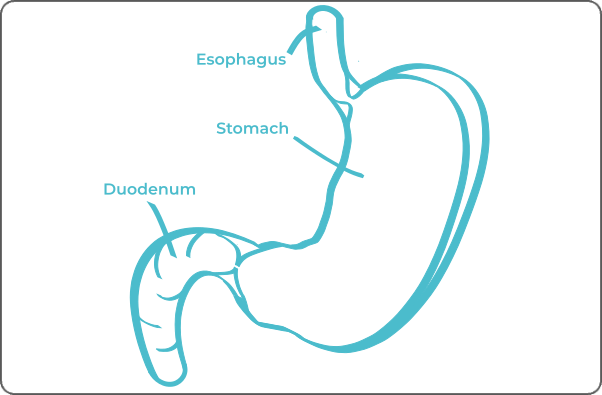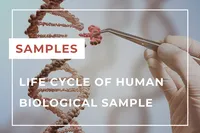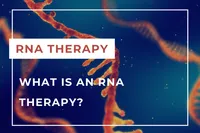Home › Biological sample › Cancer › Gastric
Gastric cancer biological samples
For research applications
The development of drugs and diagnostic tests for the treatment and detection of gastric cancer requires conducting studies on biological samples obtained from patients with cancer localized in their stomach.
A brief overview of the various types of gastric cancer and how the services offered by Labtoo contribute to accelerating research and development projects in the pharmaceutical industry.


Are you looking for biological samples from gastric cancer patients?
What are gastric tumors?
The stomach, an organ of the digestive system, functions as a temporary reservoir where ingested food is mixed with gastric juices. These juices, composed of hydrochloric acid and enzymes, break down proteins and sterilize the food. In summary, the stomach plays a crucial role in preparing food for optimal absorption in the small intestine.
The vast majority of gastric cancers, approximately 90 to 95%, originate from the glandular cells lining the gastric mucosa. These glandular cells play a fundamental role in secreting essential elements such as enzymes, gastric acids, and mucins, significantly contributing to the digestive process. Consequently, the majority of gastric cancers are classified as gastric adenocarcinomas.
Gastric adenocarcinomas constitute a predominant category of gastric cancers. However, other types of gastric cancers arising from different cell types are less common. Examples include gastrointestinal stromal tumor (GIST).

| Type of Gastric Cancer | Cell of Origin | Frequency |
|---|---|---|
| Adenocarcinoma | Glandular cells of the gastric mucosa | ≈ 90 - 95% |
| Gastric Lymphoma | Lymphatic system cells | > 5% |
| Gastrointestinal Stromal Tumor (GIST) | Stromal cells of the intestinal connective tissue | ≈ 5% |
| Leiomyosarcoma | Smooth muscle cells | > 1% |
| Neuroendocrine Tumor | Neuroendocrine cells | > 1% |
Explore Labtoo's Service for Your Biological Sample Research
Labtoo assists you in sourcing biological samples from gastric cancer patients. Our team manages the entire project of transferring biological materials from inception to sample delivery.
- Feasibility assessment of sample availability or clinical collection from referenced clinical centers
- Validation of regulatory aspects
- Establishment of a contractual framework
- Dispatch of desired samples under appropriate conditions
- Transfer of associated clinical data
- Additional analytical and experimental services
Types of available samples
Fresh tissues
After a tumor resection or a biopsy, a pathologist can decide whether the tissue sample can be used for research. Labtoo can organize the conditioning and shipment of fresh gastric cancer tissue in 24-48 hours after surgery.
Frozen tissues (OCT and FF)
Similarly to fresh tissue, once the tissues are cleared for research, the clinical site can freeze and keep the frozen gastric cancer tissue samples at -80°C or in liquid nitrogen for ulterior use.
FFPE Tissues
Pathologists typically embed the biopsies and resections in paraffin. FFPE blocks of gastric cancer tissues can be used later for research.
Adjacent Healthy Tissues
Tumor resections typically include healthy adjacent stomach tissue during the process. This tissue can later be used for research and act as controls for diseased tissues.
Hassle-free Usage
First, the problems faced by businesses are identified. Raw structured as well as unstructured data is gathered.
- Plasma or Serum from gastric cancer patients
- PBMC (Peripheral Blood Mononuclear Cells)
- Whole Blood
- Leukapheresis
- Urine
- Feces
- Other
Typical associated clinical data
-
- Age
- Gender
- Ethnicity
- TNM Classification
- Undergone Treatment
- Medical Imaging
- HIV/HBV/HCV status
- Mutations
- Other Data (upon request)

Our service identifies clinical sites allowed to prepare collections and transfer samples for a specific project.
Contact our team to discuss your project.
Send your request to our team:
The stages and grades of gastric cancer
The stage and grade of cancer are commonly used together to provide a comprehensive assessment of the disease and guide optimal treatment.
The determination of cancer stage relies primarily on the TNM classification, which evaluates the tumor size (T), the involvement of lymph nodes by cancer cells (N), and the presence of metastases in other parts of the body (M). In parallel, the grade provides an index of the degree of differentiation of cancer cells.
Regarding the grades, noted from 1 to 3, Grade G1 indicates well-differentiated cells resembling normal cells, Grade G2 represents moderately differentiated cells, and Grade G3 indicates poorly differentiated cells, suggesting faster and potentially more aggressive growth.
Concerning the stages of gastric cancer, they are represented as follows:
Stage 0
The tumor remains in the stomach mucosa, termed carcinoma in situ.
Stage I A
Invasion by the tumor into the connective tissue of the mucosa or the muscular layer of the mucosa or the submucosa.
Stage I B
Either the tumor has invaded one of the tissues mentioned in Stage I A with further spread to 2 or fewer lymph nodes.
Or the tumor has invaded the muscularis (thick muscular layer).
Stage II A
Either the tumor has invaded one of the layers mentioned in I A and has spread to 3 to 6 lymph nodes.
Or the tumor has invaded the muscularis and has spread to 1 or 2 lymph nodes.
Or the tumor has invaded the subserosa.
Stage II B
Either the tumor has invaded one of the layers mentioned in I A and has spread to 7 to 15 lymph nodes.
Or the tumor has invaded the muscularis and has spread to 3 to 6 lymph nodes.
Or the tumor has invaded the subserosa and has spread to 1 or 2 lymph nodes.
Or the tumor has penetrated the serosa.
Stage III A
Either the tumor has invaded the muscularis and has spread to 7 to 15 lymph nodes.
Or it has invaded the subserosa and has spread to 3 to 6 lymph nodes.
Or it has penetrated the serosa and has spread to 1 to 6 lymph nodes.
Or it has invaded nearby regions such as the spleen, colon, or abdominal wall.
Stage III B
Either the tumor has invaded one of the layers mentioned in I A with spread to at least 16 lymph nodes.
Or it has invaded the subserosa and has spread to 7 to 15 lymph nodes.
Or the tumor has invaded nearby regions and has spread to 1 to 6 lymph nodes.
Stage III C
Either the tumor has invaded the subserosa, or it has penetrated the serosa and has spread to at least 16 lymph nodes.
Or it has invaded nearby regions and has spread to at least 7 lymph nodes.
Stage IV
Cancer has formed metastases that have spread to other organs, including the lungs, bones, peritoneum, or omentum.

Rare forms of gastric cancer
Occasionally, rare forms of gastric cancer develop, among which are:
-
Leiomyosarcoma
These cancers develop from smooth muscle cells in the stomach wall.
-
Neuroendocrine Tumors (NET)
These tumors form from neuroendocrine cells present in the gastric mucosa.
-
Gastrointestinal Stromal Tumors (GIST)
GISTs develop from stromal cells, which are part of the connective tissue in the digestive wall.
-
Gastric lymphoma
A form of cancer that develops in the lymphatic system cells located in the stomach.
Gastric cancer treatments and advances
The treatment of gastric cancer relies on a multidisciplinary approach aiming to target the disease effectively. Several therapeutic modalities can be employed depending on the cancer stage, its location, and other individual characteristics:
-
Surgery: Surgery is the primary option for localized tumors. It may involve the removal of a part or the entirety of the stomach (gastrectomy). In some cases, surgery may be followed by digestive reconstruction.
-
Chemotherapy: Chemotherapy uses anticancer drugs to destroy or halt the growth of cancer cells. It can be administered before surgery to shrink the tumor, after surgery to eliminate remaining cells, or as the primary treatment for advanced cancers.
-
Radiotherapy: Radiotherapy uses ionizing radiation to target and destroy cancer cells. It can be administered before or after surgery or in conjunction with chemotherapy.
-
Targeted therapy: Targeted therapy specifically aims at molecules involved in tumor growth. Drugs like trastuzumab can be used for gastric cancers overexpressing certain proteins.
-
Immunotherapy: Immunotherapy stimulates the immune system to target and destroy cancer cells. It is under research for gastric cancer treatment.
-
Hormonal therapy: Rarely used in cases of gastric cancers expressing hormonal receptors. This may be applicable in treating Neuroendocrine Tumors (NET).



